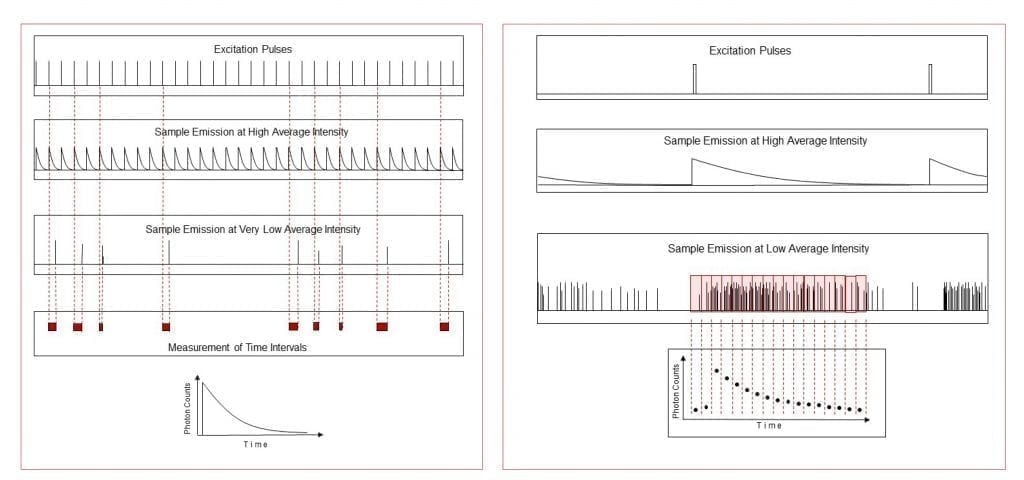Measurement of Time-Resolved Photoluminescence in the Microsecond Range
Edinburgh Instruments offers two types of photon-counting methods for time-resolved photoluminescence: Time-Correlated Single Photon Counting (TCSPC) for luminescence lifetimes between 5 ps and 50 µs, and Multi-Channel Scaling (MCS) for lifetimes between 1 µs and 10 s.
The working principle of TCSPC is explained in out previous technical note, “What is TCSPC?”. In simple terms, a histogram of signal photon counts as a function of time is built from a series of START and STOP pulses that are input to the TCSPC electronics. Typically the START pulse is an electrical trigger synchronous to the optical excitation pulse, and the STOP pulse is caused by a single photon reaching the detector. The opposite case is known as reverse TCSPC, but for simplicity we will only focus on forward TCSPC here. The time between the START and STOP pulses is recorded accurately by the electronics, which acquire millions of START-STOP sequences in order to build a photoluminescence decay (Figure 1). 
Figure 1 (left): Schematic of TCSPC measurement. A source produces optical excitation pulses at a fixed repetition rate, and at the same time triggers the START of the TCSPC electronics. The excitation intensity must be fine-tuned to obtain a very low rate of detected photons (this is the STOP rate). The START-STOP delay is recorded by the electronics and a histogram of photon counts vs time is built.
Figure 2 (right): The figure on the right shows the MCS measurement schematic. Emission photons are counted and assigned to time bins. The procedure is repeated after each excitation pulse to build a histogram of photon counts vs time, with the excitation pulse at the start.
Edinburgh Instruments spectrometers can be configured with TCSPC, MCS, or both; depending on your time resolution requirement. However configuring your instrument for fluorescence lifetime is not as simple as choosing the acquisition electronics. The measurable range of lifetimes depends not only on the electronics but also on the excitation source and the detector used. The width of the excitation pulse and the detector response time have a major effect on the instrument response function (IRF). These considerations are particularly important when the samples studied have multiple lifetimes across the ns and μs ranges; or when their lifetime is of the order of 500 ps – 5 μs, the crossover region between TCSPC and MCS.
In this technical note we present different examples of source and detection method combinations and show how the choice of configuration affects the measurement quality. Focusing on the FS5 and FLS1000 spectrometers, we introduce the new capability of EPL and EPLED pulsed diodes as MCS sources, which helps bridge the gap between TCSPC and MCS.
Download Time-Resolved Photoluminescence Technical Note
Download the complete technical note: Measurement of Time-Resolved Photoluminescence in the µs Range
FLS 1000 Photoluminescence Spectrometer and FS5 Spectrofluorometer
For further information on our instrumentation, why not contact one of our sales team today email us at sales@edinst.com or give us a call on +44 (0) 1506 425300
Sign-Up for our Application and Technical Notes
If you have enjoyed reading our Technical Note, why not sign-up to our infrequent newsletter via our red Sign-up button below.








